#rocaille rule
Explore tagged Tumblr posts
Text
Me when I forgor to post horse💀
From left to right, Starshine is owned by @giestnacht, Moonlight Sonata is owned by @raisedbybatz, and Velvet Rose is owned by @raineylatte! GoodyGraces is owned by me (:

#mlp oc art#art#digital art#character art#artists on tumblr#oc art#my art#oc artwork#digital artist#digital sketch#mlp art#rocaille#rocaille rule
5 notes
·
View notes
Text
wmmap cast & Fabergé eggs
cause I fell down the rabbit hole while researching Imperial families especially the Russian one for well.. writing? (Imma keep that hush hush though aha) and wanted to share~
Athanasia: Tsarevich which was given to the Empress as a gift. (It was this or the Kelch Chanticleer but I chose this because the other one was given as a gift by an industrialist to his wife- he wasn’t royalty so I was like nah- also that one had a chicken on the top..it may be diamond studded but still..not cool..)

Claude: Blue Serpent Clock (nuff said? I mean? Look at it? Then Claude?)
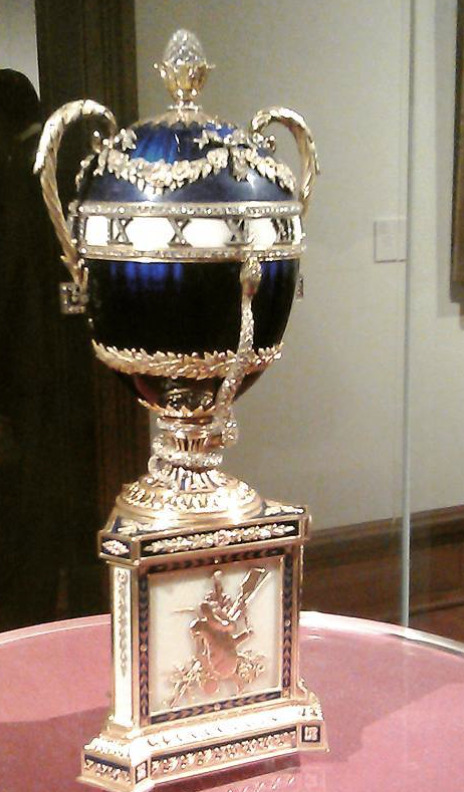
Diana: Duchess of Marlborough (Diana=pink and gold perfection, need I say anymore??? Although this might have worked for Athy too but I wanted hers to be more Empress like)

Felix: Nobel Ice (before you say it’s plain compared to the others: I think this is the prettiest because of its snowflake design like ahhh look at how elegant it is!?)

Lilian: Basket of Flowers (there was a lily only version but flowers have thorns too, right?)

Ijekiel: Imperial Coronation (fittingly this should’ve been for Athy or Claude buttttt look at the gold!!! I’m a sucker for his eyes whoops)
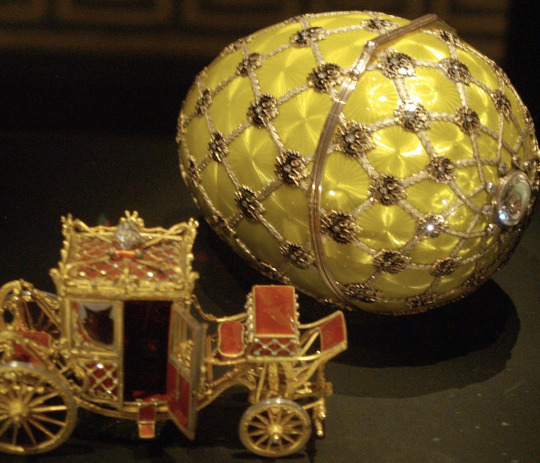
Lucas: the Rosebud (there was one called the Hen which had a deeper red color but I feel like Lucas-lovers would have tackled me for putting that cause of the name lmao)
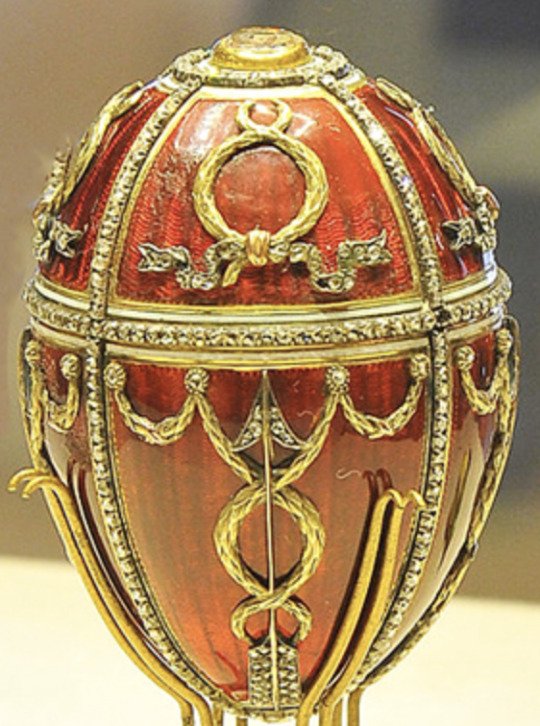
Jennette: Kelch Rocaille

Anastasius: Third Imperial

Below are other designs that didn’t quite fit what I had in mind for Athy and Claude’s and were passed over.

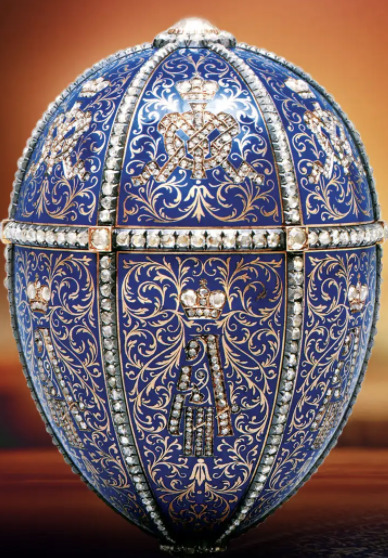
Or this one(Rothschild) for Diana..

Or the Baytree for Jennette

Of course, Faberge has come back to life with new designs in recent years(like the one with pearls or the GOT version) but I’ve chosen to put ones that were originally out of the 50 that were commissioned during the rule of the Emperor.
#wmmap lucas#wmmap athanasia#wmmap athy#wmmap lily#wmmap ijekiel#wmmap#who made me a princess#who made me a princess athanasia#i suddenly became a princess#suddenlyibecameaprincessoneday#suddenly became a princess#suddenly i became a princess#suddenly became a princess one day#sibapod#sibapod athy#isbapod#Lilian York#felix robane#wmmap felix#claude de alger obelia#wmmap claude#Ijekiel Alpheus#felix robain#i suddenly became a princess one day#sbapod#sbapod athy#who made me a princess athy#who made me a princess one day#wmmap diana#claudiana
35 notes
·
View notes
Text
So a couple years back I wrote this fanfic that was sorta of hit for another fandom(wtfock or belgium skam). I’ve been wanting to write something for young royals for awhile but I knew I wanted to do it in that similar style of that past fic because people seemed to LOVE that parallel puzzle piece timeline style. Anyways so surprise surprise gonna be dropping chapter 1 soon but here is a preview. Oh, and one last thing:
Fic Rules
If its in italics its the past
If its not in Italics its the present (particular scenes from the last year)
Into The Blues
We’re all just journeymen in catacombs of the earth’s womb.
Riding life like a log down a stream burrowing through artificial portholes that men sowed into the roots of the city as an act of defiance; when travel above the waterline did not suffice.So instead we defiled her core from the inside out.
Yet, here we find him.The interloper standing shoulder to shoulder in a cigar shaped transport vessel amongst the everyman attempting to blend into a world he no longer belongs too. Sporting garments perfectly hand crafted by french artisans for his physique and leather bound shoes of italian origin.
The commuter populace sways as the ocean does in twilight. Mellow and familiar. Unobstructed and in uniformity.
The conductor breaks his mental surface.
“Mind the gap between the train and the platform. This is Green Park.”
He navigates the route towards an exit. He is late but he insisted on venturing into the world as the common folks do.
This isn’t his side of town and if given a choice he wouldn’t have hosted the Royals Arts Gala here but the honorees were swedish alums of The Royal Academy Art who were funded by the Swedish Royals Arts Foundation so a marriage of both Swedish and British houses had to be decided and London seemed to appeal to a wider audience.
He scurries out of underground to street level when the harsh cold air hits him. A loving reminder he thinks to himself.
Reality gnaws at him when he sees it. The Ritz Hotel signage glowing back at him.
A wave of guilt washes over him from sins past and yet here he finds himself once again running towards his mistakes atop a pair of italian soles that would entice even the top ranks of the Bourgeoisie.
He picks up pace and jettisons towards the Grand Ballroom as tear drops begin to fall from the heavens.
You’d think after years of exposure to all this pomp and circumstance he’d be used to the classic french rococo style but it still feels so grandiose at times. Banquet rooms adorned with gold leaf walls, gilded oak paneling richly embellished with C-scrolls and S-scrolls, sprigs of flowers, rocaille motifs and hand painted frescos. 18th century crystal chandeliers prevailing in their usage to light an avarice crowd of thespians devouring the fruits of France's champagne region like it was manna from heaven.
But he needn’t worry tonight because these throngs of acolytes were here to bear witness to his recital of one sacrosanct individual.
However, before he stood atop a podium for his song and dance routine he kept his interactions with the crowd wrapped up in an air of breviloquence and wit.
He’d be expected to frolic amongst the flock and express his gratuity for the copious amounts of flowers, gift baskets and condolences sent his way. Though arduous work, he had an inert sensibility when it came to working a room of uppercrust socialites after years of conditioning.
“Hello sir, this way please” a gala usher quickly takes his coat and escorts him to his table for the evening when an unfamiliar sensation reemerges from eons past. A fibrillation in his heart, one mimicking that of a hummingbird in fast pursuit. He hadn’t had much time to ponder this strange occurrence when he noticed the guest at his table standing up to greet him.
Anders Olsson was the first to lock gaze with him. He greeted him with an overworked smile and spread out arms welcoming him into a fast embrace.
“Am so happy you came” Anders whispered in his ear softly as he pushed off from their hug.
Then Anders immediately went around the table introducing him to the director of the Royal Academy who gave him an assertive handshake, the other honorees who’s displays of dominance were absent and meekly greeted him,the gala’s main sponsors two Americans one of which was sat next to him and felt the need to remind him that she was a hugger and gave him a good squeeze before he could even object, and lastly the person sitting directly to his left the head of the Swedish Royals Arts Foundation.
“Prince Wilhelm, this is Simon Bancroft-Erikksen, Tomas’s husband” Anders confirms.
“Hey”, Wilhelm states softly as he embraces Simon’s handshake with a dual hand handshake creating an over-under type of shelter for Simon’s touch.
Simon’s notices Wilhelm linger and slides his hand back slowly.
“Hi” Simon says softly as he musters his best subdued smile for his highness.
As Simon takes a seat he notices a few patrons looking directly at him as they cover their mouths and about his recent life updates. Forgetting for a moment that he is “that” guy now.
Simon Bancroft-Erikksen, a swedish born singer/composer, recent widower to the late Tomas Åström Bancroft and now sole heir to the Bancroft banking fortune. A fortune worth more than some countries GDP.
It was like looking through a lens but fish eyed, distorted and misshapen.
Lacking distinction, and depth, an exam based on muscle memory and repetition. A performance of sorts.
“Simon, how are you?”, They asked with a worry in their voice that had become oh so familiar.
“Am good”
“Simon, are you getting enough sleep?” This was definitely somewhere in the top 3 questions as of late.
*Shrugs*
“Are you eating?” and this question? This one usually led to a non sequitur from him.
“Oh pardon me. I see a colleague, I must run to say hello too.” This was Simon’s cue to beeline it back to his table and avoid the thickets of bullshit he had to spatter.
Simon plopped himself back down on his seat and took a deep exhale.
“I brought reinforcements,” Simon heard him say.
Wilhelm shot him a sweet smile as he picked out a small plastic bag from his blazer.
Simon’s eyes widened and for the first time tonight and he genuinely smiled.
Simon couldn’t decide which one to choose from so he went for his usual sweet and salty licorice. Swedish candy had become Simon’s main food source throughout this period in his life. It was one of the only things he could stomach to keep down. That and mandarins.
“Thanks, you’re a lifesaver.”
“I had an inclination that you may need backup.”
Simon shook his head in agreement.
“You’re doing great,by the way” Wilhelm encouraged Simon somewhat gingerly.
The ballroom lights dimmed and the ceremony got underway.
Notable honorees received their totems of recognition from high society.
And then a darkness befell them and he felt the room surround him and suddenly there he was in full technicolor. Tomas and Anders discussing the inspiration for what would become Tomas’s final commissioned symphony.
It was a strange sensation for Simon. In many ways he thought he had become infallible to public displays of sorrow. He’d numbed himself to a point of no return, gone full scorched earth, become some sort of cultural philistine with a match in his hand walking on gas ready to ignite the pain away.
Pay no credence to his grief.
Yet, The chinks in his armor began to chime through the air like a siren’s song.
Without notice Simon’s body began to react badly. His hands began to shake as Tomas’s voice filled the room. He hid his hands underneath the table but the shaking only worsened and as Simon was about to deploy his metaphorical airbag and abort this mission. Wilhelm tethered him back down to earth. Threw him a safety line and kept him at bay and from floating away. Wilhelm took a hold of Simon’s hand and interlaced his fingers into Simons.
Simon was fully prepared to shoot Wilhelm a rather terse glance when suddenly the lights went up and the crowd stood up for a standing ovation. Wilhelm pulled Simon up with the crowd and let go of his hand to indulge in the clapping.
Ander’s walked over to him and before he knew it they were walking in the direction of the podium. Simon wasn’t taken aback by this gesture if anything he expected. He had written a speech and all but it was all happening so fast. The spotlight flashed atop of him and he stood there looking out at a sea of onlookers.
He pulled the mic towards him and reached into his blazer pocket to read from a cue card.
“Firstly, I would like to say thank you for the beautiful in memoriam segment and to everyone who has sent their condolences to my family throughout the last year.
My husband Tomas was a kind and thoughtful soul who truly inspired me and many others. When he began this consortium project he felt a great responsibility to represent the cultural richness of the great landmarks of Sweden. His music was merely a vehicle to explore what he felt in his heart was an undeniably beautiful landscape filled with everlasting summers and a wonderful winter wonderland. Except for those 4 months in the dead of winter which we don’t talk about.”
The crowd broke out in laughter.
“Thank you for honoring Tomas’s legacy and to the Swedish Royals Arts Foundation for recognizing his accomplishments, To the Royal Academy for their constant support and to the Bancroft foundation for their relentless advocacy in forestry conservation.”
Applause raptured around the ballroom.
As Simon stepped back from the mic his heart rate adjusted and he looked out into the crowd for a tether back into the normal world. The one where he once felt he belonged to, had a home in, fell in love in and felt like he could operate within without fear or reservations.
As Simon walked off stage he felt a tug, a reel, a life line leading him to a sanctuary where he could be caught and released out of these predatory waters. This wildlife was foreign to him now. He needed to live in a habitat where the aquamarine life was curated and made out of plastic.
He needed everything to be fake, to go to a place where he could be inoculated from his reality. Where none of the people were real and just made out of metal.
There was only one exception to this rule.
As he took his seat again and looked to his left; it was all gut, an unfathomable feeling, a pavlovian response as he reached out underneath the table and took hold of Wilhelm’s hand and thought to himself.
This, and only this, he needed to be real.
#young royals#my young royals fic#preview to my debut hoping to get this fic out this week or so#early xmas present#new fic coming soon
2 notes
·
View notes
Text
Fritz' Music Room!

This the most decorated room in the palace; it's where Fritz would hold his concerts. In a very Rococo palace, this room is the most Rococo.
So Rococo comes from the french word Rocaille meaning shell/rock work. It's defined by all the organic shapes often inspired by shells. It's most obvious in the paintings/mirror frames:


And Frederick was a very stubborn man. So despite there being established trends and rules to Rococo design, Fritz decided to make his own rules. He picked most what he liked from French, Dutch, and German Rococo and combined it into what is now called Frederician Rococo.
The paintings are by Antoine Pesne depicting scenes from Ovid's Metamorphoses (Pygmalion and Galatea, Vertumnus and Pomona, Pan and Syrinx, Bacchus and Ariadne). The large painting behind the flute is Diana bathing:

Again, nature is a big theme here. There's nature everywhere on the walls (especially grapes and vines) and there's bouquets of musical instruments hidden throughout the gold decorations too. There's even a spiderweb on the ceiling:

And here's his famous flute!:

And here's a 360° shot I took on my phone. It's a bit wonky on here but I'll post it anyway in case anyone wants to see:

#im baaaack#took a bit of a break#i finished up the sans souci pics and theyre scheduled to post every hour#lola does germany#frederick the great
24 notes
·
View notes
Text
Portfolio 5-6 (1)
The Romantic Era, circa 1790-1830
This era was known for it’s depictions of feelings and emotions. It has a palpable message, and was known for varying subject matter...landscapes, religion, peace, war, etc. At this time, it was believed that the artist’s imagination dictated the direction of the art...with no influence of ‘artificial’ rules of what art should be.

Above is an example of Romantic Era art. ‘Liberty Leading the People’ is a work done by Eugene Delacroix in 1830. The emotion, movement, and chaos in this work is palpable, as intended.

This is another example of Romanticism. ‘Salisbury Cathedral from the Meadows’-a work of John Constable c. 1831
This piece is a soft, peaceful landscape, indicating how versatile this Era was.
Rococo
According to Miriam-Webster: In the 18th century, French artists rebelled against the ponderousness of Baroque style and began to create light, delicate interior decorations, furniture, and architectural elements characterized by fanciful curved asymmetrical forms and elaborate ornamentation. The name of their new style, rococo, has been traced to the French rocaille, a term that evoked the ornamental use of rock and shell forms. In time, rococo was also applied to similarly ornamented and intimate styles of painting and music. But all fashions fade, and by the mid-1800s the rococo style was deemed excessively ornate and out-of-date. Now rococo is often used with mild disdain to describe the overly elaborate.

Pictured above is a great example of Rococo. Simply stated, it is a gross overstatement. The intricacies of this style are almost overwhelming. I’m not sure how anyone could relax in this kind of environment. It’s sensory over stimulation, in my opinion.
2 notes
·
View notes
Text
The Rose of Highgarden. On Margaery Tyrell (part 2)
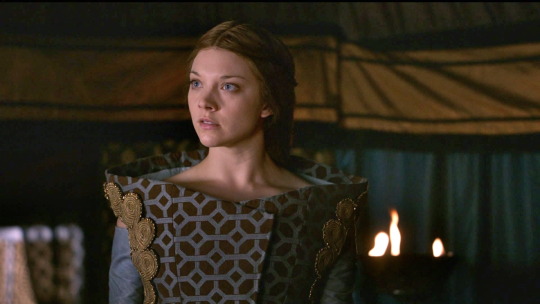
This is the second part in a series of metas about Margaery Tyrell in Game of Thrones (Part 1). In the first part I wrote about Margaery’s narrative arc and her characterization in season 2 - the season where’s she first introduced. In this post I will take a closer look at her costumes in this season.
Costume design is a particular interest of mine and Game of Thrones has some of the most interesting costumes on television - especially when it comes to the female characters. The award-winning costumier Michele Clapton’s work for the show is very original and in several cases visually arresting. However, a lot of fans have complained that the costumes are not medievalist enough. While I do think that this argument has some merit, I personally have no problem with the fact that Clapton’s work isn’t very medievalist. Whilst the feudal society of Westeros is largely inspired by 15th century England, it is also a fantasy world and that means that the costumes don’t necessarily have to be period specific.
Clapton’s decision not to go medievalist is a conscious choice since she has previously worked on period pieces such as the Jane Austen adaptation Sense & Sensibility (2008) and the English Civil War drama The Devil’s Whore (2008), for which she won a BAFTA. Instead, she has chosen to take inspiration from both history and high fashion:
“I look at contemporary fashion and art,” she says. (x)
When it comes to the costumes of Game of Thrones, Clapton have taken a very eclectic approach with inspiration from a number of different sources: historical costume, contemporary couture and vintage fashion. While her costumes may not be “historically correct”, which btw is a bit of an anachronistic concept when it comes to fantasy, her eclectic approach has yielded a number of original and iconic costumes that have prompted a number of articles in various news outlets.
Whilst a number of fans have decried her costumes as ugly, they overlook the fact that in television and cinema, costume design is not just about making pretty clothes - rather it is about supporting and articulating the characterization in relation to the narrative.
Even in real life, clothes is more than just about functionality and aesthetics. It is also a form of communication, which is why there’s an entire discipline dedicated to the communicative aspects of clothing that is called fashion semiotics.
Semiotics is the study of how people understand or make sense of life events or relationships. It is the study of sign processes and meaningful communication. Likewise, fashion is a language which holds a symbolic and communicative role. It helps express one’s unique style, identity, profession, social status, and gender or group affiliation. Therefore, the semiotics of fashion is the study of fashion and how humans symbolize specific social and cultural positions through dress.
Garments are non-verbal signs that can be interpreted differently depending on the context, situation or culture. Hence, fashion significance is constructed depending on culturally accepted codes. For example, in Western cultures white color is chosen for weddings because it represents purity while in Asian cultures this color means death and is most likely used in funerals.
Dress codes identify individuals within a culture. (x)
The same thing applies to how costumes work as meaningful elements in a visual narrative - and this is exactly the approach that Michele Clapton has adopted for her work on GoT:
For her, the key is looking at costume design as a mode of storytelling. “It’s so easy to draw a pretty dress in a fun way,” Clapton told Fast Company. “But this is so much more about finding the right look and telling so much more about that character, and that’s what I really, really enjoy: the storytelling.” (x)
Therefore, when we look at the costume design in this show, we have to ask what it says about the characters.
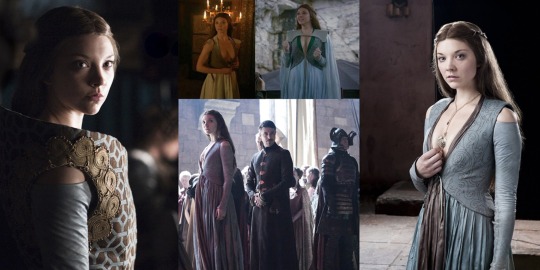
So what does Margaery Tyrell’s costumes say about her in season 2?
BOLD AND SEDUCTIVE
Margaery has three different costumes in season 2. Two of these dresses have the same basic design and silhouette whereas the third is perhaps one of the most unique costumes in the entire show. I’m going to start with a look at the gown we see in Margaery’s last scene in season 2 - the light blue gown with the rocaille pattern on the bodice.
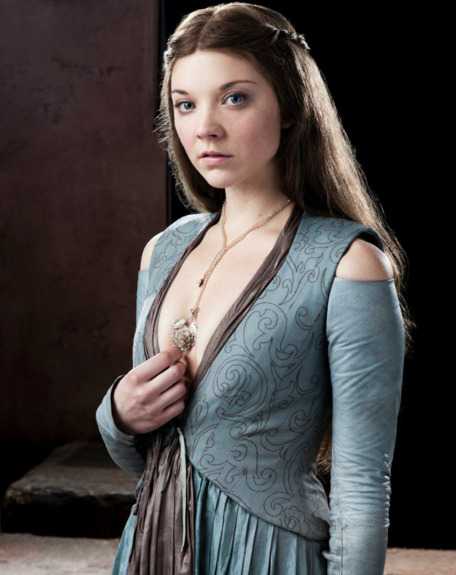
Unlike the red-gold costumes of the Lannisters in season 2, Margaery’s costumes don’t use the green-gold colours of House Tyrell. This is something that a number of fans objected to but this article argues that the use of light colours such a soft blue and purple serves as a subtle contrast to the power dressing of the Lannisters. The Tyrells are just as ambitious as the Lannisters but they are subtle about it and with the use of soft colours, they make themselves look non-threatening whilst they secret plot to extend their political influence.
This dress also feature a rocaille pattern on this bodice. In an art historical context, rocaille denotes an exuberant and elaborate form of ornamentation associated with the rococo style of the 18th century.

The aristocratic culture that the rococo style is associated with was in many ways a hedonistic, sophisticated and somewhat frivolous culture that put a lot of focus on the love of pleasure. In the context of this costume, the use of the rocaille pattern may serve as a hint that the culture of the Reach, which the Tyrells rule, is one associated with abundance, pleasure and cultural sophistication.
Another aspect of this costume is that it is quite revealing - as we’ll see in season 3, the costumes of Margaery Tyrell and her ladies feature a lot of cut-outs as well as plunging necklines, which hints at the warmer climate of the Reach as well as a more hedonistic culture than what we see in the North and the Crownlands. The most noticeable element of this dress is the plunging neckline, which emphasizes Margaery’s bold sexuality. However, the revealing nature of this gown also works at a metaphorical level:
Cersei hides behind her clothes, and Margaery instead chooses to expose herself. A very nice and metaphorical way of showing to the people at King's Landing that she has nothing to hide. This also allows her to expose large amounts of skin, which not only helps cement the idea that the Tyrells come from a warmer weather (as mentioned earlier) but also helps cement the idea that she uses her sexuality and femininity as a political tool in itself. Presenting herself as a young, delicate and alluring girl, she avoids being perceived as a player in the game, even though she very much is. (x)
It is thus ironic that Margaery wears this particular outfit in a scene where she is dishonest when she talks about how she’s come to Joffrey from afar. In this scene Margaery acts bashful and girlish, the role of the innocent maid, which the audience already knows is an act.
During the entire conversation between Joffrey, Loras and Margaery, she utilizes a specific kind of performative femininity, i.e. she tailors her courtly performance so it conforms to a very specific ideal of femininity: the bashful and innocent maid. Notice how she initially keeps her gaze lowered, signalling meek sub-mission. When Joffrey professes his admiration of her, she lifts her gaze and bats her eyes at him, which is a very calculated move. (x)
This is underscored by a costume where the sexy neckline stands in contrast to the softness of the light blue colour. In this context, it is interesting to compare and contrast Margaery’s costume with one of the dresses that Sansa Stark wears in season 1.
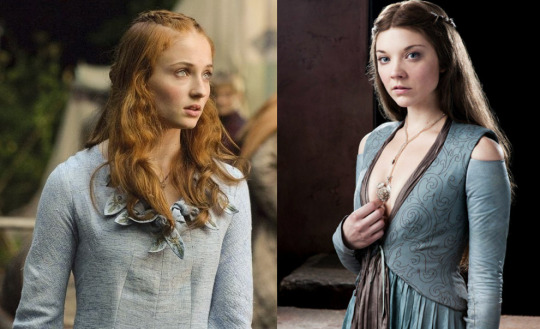
Whilst the colour is very similar, the cut and silhouettes of the two gowns couldn’t be more different. Sansa’s gown is modest and loose, hiding her body, whereas Margaery’s gown is close-fitting and very revealing. This highlights the differences between the two characters. Sansa IS an innocent young girl whereas Margaery is a sexually confident woman who simply plays the role of the bashful maid.
FASHION QUEEN
Let’s take a look at the costume Margaery wears when the audience is introduced to her character. First of all, this gown is identical in design to the light blue gown I mentioned above. However, in this scene Margaery has donned a rather unconventional cloak that stylistically sets her apart from any other female character we’ve seen so far.
Like the gown above, this outfit emphasizes Margaery’s confident sexuality. Not only does it have a deeply plunging neckline but the beaded strings that are attached to the button at the front of the cape serve to draw visual attention to her exposed cleavage.

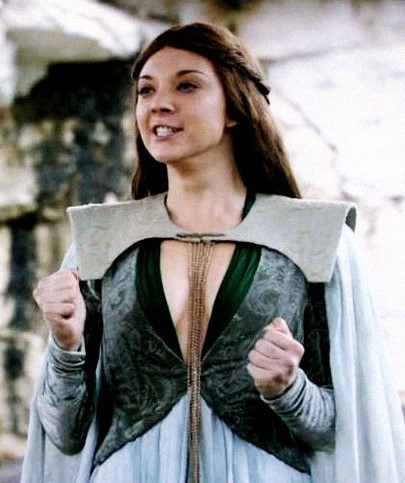
Apart from the plunging neckline, the most visually arresting element of this costume is the structured shoulders of the billowing cloak. This gives the outfit a slightly armoured “feel”:
She dons a billowing cape with structured shoulders that give a sense of armor. It is interesting to note the armor-like aspect of most of Margaery’s season two outfits. She spends the majority of the season at Renly’s camp in Storm’s End while the Tyrell/Baratheon forces prepare for war. Without the security of castle walls for protection, perhaps this is her more feminine way of being always armed and on guard for whatever is in store. (x)
The armoured aspect is an interesting one in terms of character. However, in relation to this costume the armoured “feel” of the shoulder piece takes on a rather tongue-in-cheek aspect since it is paired with a very lightweight fabric that billows in the wind. This is play-acting, which resonates perfectly with Margaery’s presence at a tourney where knights play at war whilst a real war rages elsewhere. However, this costume also signals that Margaery is fashion-forward in a sense few other Westerosi women are. She’s the consort of a royal pretender who wants to present an alternative to the current regime - and Margaery mirrors that by setting herself up as stylistically different, as a future taste-maker.
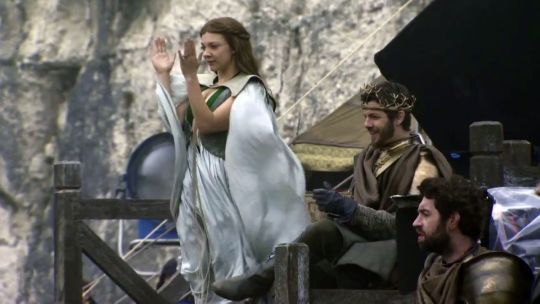
It is interesting to note that Margaery wears a kind of scarf underneath the bodice in order to make the neckline LESS revealing. The tent scene with Renly shows EXACTLY how deep the neckline really is.
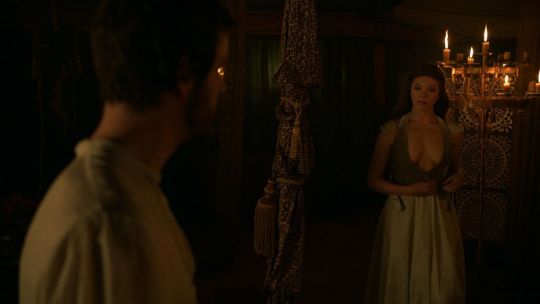
Here the revealing nature of the costume supports both the narrative and the character. In this scene Margaery tries to seduce her reluctant husband but she also reveals her pragmatic nature - as I’ve detailed in my previous post.
ARMOURED IN FASHION
The third costume that Margaery Tyrell wears in season 2 is perhaps the most avantgarde and also the most controversial costume on the show. I am, of course, speaking of the now infamous funnel dress that Clapton designed as an homage to Alexandre McQueen’s iconic Bell Dress that he made for Björk in 2004.

Margaery's funnel dress was obviously an homage to the wonderful Alexander McQueen's costume for Bjork. It just felt right that this young ambitious girl would be experimenting with shapes, honing her style skills which we now see her employing to great effect. It was a risk and divided the audience. (x)
“From the very beginning she is brave and experimental in her look, which I wanted. She was a young girl who wanted to be the queen,” Clapton explained.
Margaery is often spotted in revealing or outré outfits. One episode she wore a funnel dress that Clapton told Vogue was an homage to an Alexander McQueen dress made for Bjork. “It was ridiculous. She’s a teenage girl trying things out.” (x)
Clapton designed this dress to emphasize that Margaery is rather avantgarde in terms of style. She’s experimenting style-wise but this look is so radical in relation to the rest of the fashions of Westeros that I cannot help but think that she’s also trying to create a new paradigm. She wants to stand out, to be seen as different from everybody else.
Another aspect of the funnel dress is that it has an armoured “feel” that is even stronger than the structured shoulder piece she wears at the tourney. The dress itself is made from a much heavier fabric than her low-cut, lightweight dresses and it has a very structured silhouette - and in contrast to her two other gowns it covers her completely.
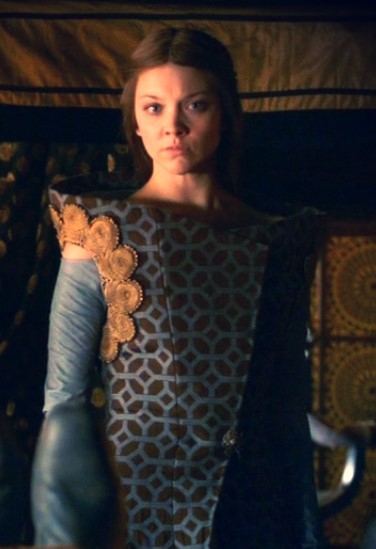
The funnel dress essentially functions as a structured coat-dress that Margaery wears over one of her more revealing dresses. If you look closely, you can see that the blue sleeves with the cut-outs over the shoulders match the seductive blue dress that she wears in the scene where she’s betrothed to Joffrey.
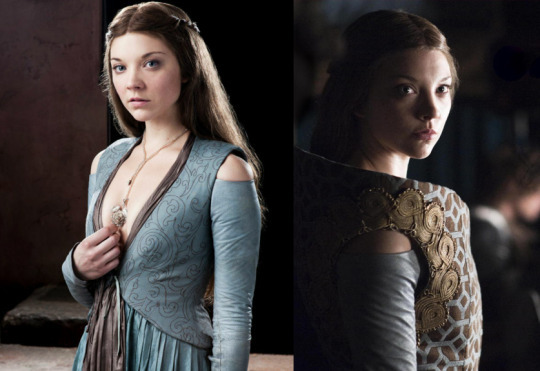
Once again, the costume design supports the overall narrative since Margaery wears this dress in two scenes where she is in a defensive position - Lady Sansa Stark was taught that courtsey is a lady’s armour but for Margaery, fashion can be armour as well:
We witness Margaery’s armor full-on with her infamous “cone-dress”. She wears this in two scenes, and is speaking with Littlefinger in both. She knows this is a man with whom you must always be on your guard, and this is reflected in the heavy satins and silk embroidery, but she keeps her shoulders exposed just enough to maintain a feminine air. (x)
It is noteworthy that Margaery only wears this dress in scenes where she is in a defensive position. The first time in the scene with Baelish where he’s questioning the status of her marriage to Renly and the second time after Renly’s death where Margaery is quietly scared because she knows exactly how dangerous the situation has become for both herself and her family.
TOO AVANTGARDE?
The funnel dress turned out to be a very controversial costume in terms of audience reception. It was the subject of a number of think-pieces but here I’ll just focus on article since its arguments exhibit a couple of different argumentative fallacies.
Let’s get the obvious out of the way first: this costume is ugly. It has no redeeming qualities. It isn’t fashion-forward in any sense. It isn’t interesting. It isn’t even well-made (note the seam where the pattern does not align: on the front of the damn garment!). I can’t even give credit where credit is due regarding the embroidery, which must have taken hours, because the embroidery is so ugly. (Fandomentals)
It is a perfectly valid opinion to say that this dress is ugly. It is, after all, a matter of taste. However, the quote above is followed by this little tidbit:
....the sheer and objective ugliness of this costume. (Fandomentals)
It is one thing to say I don’t like this dress, it is another thing to call it “objectively” ugly as this is just manifestly wrong. When it comes to aesthetics, beauty is always in the eyes of the beholder. Presenting a subjective opinion as an objective fact is a bad faith argument and it undermines what the author’s point.
Then they go on saying that such an avantgarde dress is unbelievable in a feaudal society based on the medieval period of European history - conveniently ignoring that there plenty of outrageous and not very functional fashions has existed throughout history.
While there are fashion trends in Westeros, there isn’t high fashion as we know it today. No one is picking bizarre pieces off the runways in Milan or opining over Vogue. There are no catwalks in the Reach, and there is no King’s Landing couture (though I wish there was!). Westeros is a world based on medieval human history, where men and women wore clothing to express their status in society. Clothing served a functional purpose and certainly did not step out of the norm to this extent. (Fandomentals)
It is also an argument that displays a lack of knowledge about the history of dress. Whilst there was no fashion industry in the middle ages and the renaissance, the concept of fashion as related to clothing styles did in fact exist as early as the 12th century:
How are we to distinguish between a culture organized around fashion, and one where the desire for novel adornment is latent, intermittent, or prohibited? How do fashion systems organize social hierarchies, individual psychology, creativity, and production? Medieval French culture offers a case study of "systematic fashion", demonstrating desire for novelty, rejection of the old in favor of the new, and criticism of outrageous display.
Texts from the twelfth and thirteenth centuries describe how cleverly-cut garments or unique possessions make a character distinctive, and even offer advice on how to look attractive on a budget or gain enough spending money to shop for oneself. Such descriptions suggest fashion's presence, yet accepted notions date the birth of Western fashion to the mid-fourteenth-century revolution in men's clothing styles. A fashion system must have been present prior to this 'revolution' in styles to facilitate such changes, and abundant evidence for the existence of such a system is cogently set out in this study. Ultimately, fashion is a conceptual system expressed by words evaluating a style's ephemeral worth, and changes in visual details are symptomatic, rather than determinative. (x)
Secondly, fashion trends most certainly did exist in the past - just not in the forms we know today, i.e. supported and embedded in an industry. During the medieval age, the renaissance and the baroque the taste makers who set the fashion where individuals, royal and aristocratic men and women. There are numerous examples of aristocratic fashions that were not about function but about display. What this writer fail to understand is that all clothing is part of the semiotics of fashion. Clothing and bodily decoration have always been both about beauty as well as about signalling social standing and/or political affiliation. ALWAYS.
Thirdly, costume design is an integral part of the visual story-telling and thus the costumes serve a larger function than just world-building. The relation between story-telling and costume design is something that Clapton herself emphasizes:
...viewers should consider the bigger picture and storyline to understand costume choice–or even to look for hints about how a character is evolving. “I don’t think any costume should be looked at in isolation, rather, through the arc of the character,” Clapton says. “Each thing will tell a story. It might look like a costume is wrong, but actually it’s supposed to look like that. It’s telling you something about the character at the time.” (x)
Ultimately, the question is not whether Margaery’s funnel dress is ugly, pretty or historically correct. It serves a narrative purpose and it serves it well as I’ve argued above. Not only does this dress reflect Margaery’s bold personality but it also functions as her armour in situations where she is in a defensive position and in that context I find that this particular costume makes perfect sense.
A QUEEN WITHOUT A CROWN
There’s one final detail that I want to address. Unlike her husband, Margaery doesn’t wear a crown even though she is addressed as Your Grace, which is a title reserved for royalty. From a Watsonian perspective it would make sense for Margaery to wear a crown since she’s the consort to a man who has proclaimed himself king and who wears a crown himself.
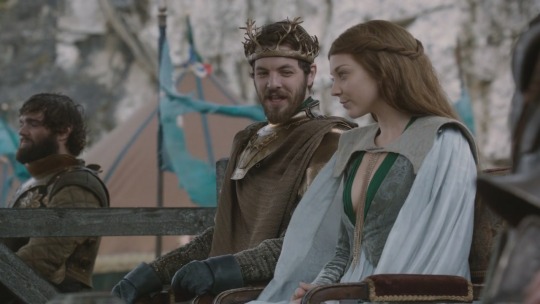
However, in this case, Margaery not wearing a crown is connected to her narrative arc. In the scene with Baelish where she proclaims that she wants to be THE queen, Margaery has come to realize that “Calling yourself a king doesn’t make you one”. She realizes that Renly wasn’t really a king and therefore she wasn’t really a queen. Clapton pays attention to details like this and that is why she didn’t make a crown for Daenerys in season 7:
Well, she's not the queen yet. You can't have a crown until you are queen. You can have the chain, but until you get the throne you're not queen. (x)
Thus, the fact that Margaery never wears a crown during her short-lived marriage to Renly is less about world-building and more about the narrative.
Thanks to @lilbreck for the edits.
122 notes
·
View notes
Text
Rules: Bold what you prefer and tag people you want to get to know better.
I was tagged by @rocaille
I tag: @madamepretentious, @chlora-virgo, @reosia, @dollfromtheattic
coffee or tea / early bird or night owl / chocolate or vanilla
silver or gold / pop or alternative / freckles or dimples
snakes or sharks / ivory or scarlet / flute or lyre
butterflies or honeybees / macarons or eclairs / rooftop or balcony
typewritten or handwritten letters / spicy or mild / london or paris
secret garden or secret library / potions or spells / ocean or desert
vincent van gogh or claude monet / denim or leather / mermaid or siren
masquerade ball or cocktail party / sun or moon / herbs or flowers
pearls or diamonds / watermelons or peaches / tattoos or piercings
beauxbatons or durmstrang / candles or fairy lights / classic or modern art
paintings or sculptures / hot or iced / glitter or matte
scorpio or cancer / silk or lace / New York or Los Angeles
3 notes
·
View notes